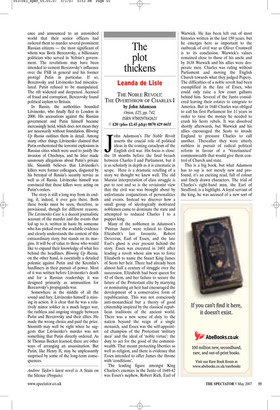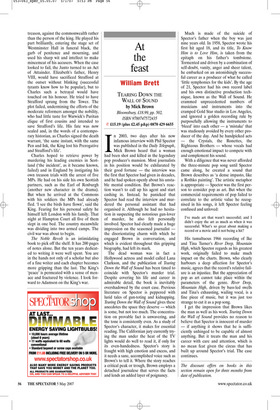The plot thickens
Leanda de Lisle
THE NOBLE REVOLT: THE OVERTHROW OF CHARLES I by John Adamson Orion, £25, pp. 742, ISBN 9780297842621 ✆ £20 (plus £2.45 p&p) 0870 429 6655 John Adamson’s The Noble Revolt asserts the crucial role of political ideas in the coming cataclysm of the English civil war. His focus is close: the 18 months before the final breach between Charles I and Parliament, but it is as scholarly in depth as it is cinematic in scope. Here is a dramatic retelling of a story we thought we knew well. The old Marxist interpretation of class struggle is put to rest and so is the revisionist view that the civil war was brought about by unfortunate conjunctions of personalities and events. Instead we discover how a small group of ideologically motivated noblemen came to dominate the state and attempted to reduced Charles I to a puppet king.
Many of the noblemen in Adamson’s ‘Puritan Junto’ were related to Queen Elizabeth’s last favourite, Robert Devereux, Earl of Essex, and the late Earl’s ghost is ever present behind the story. Essex was executed in 1601 after leading a revolt whose aim was to force Elizabeth to name the Stuart King James of Scots her heir. There had already been almost half a century of struggle over the succession. Elizabeth had been queen for 43 of them, and her failure to secure the future of the Protestant elite by marrying or nominating an heir had encouraged the development of a conservative form of republicanism. This was not consciously anti-monarchical but a theory of good citizenship inspired by the classical republican traditions of the ancient world. There was a new sense of duty to the nation beyond the reign of a single monarch, and Essex was the self-appointed champion of the Protestant ‘military men’ and the ideal of ‘noble virtue’: the duty to act for the good of the commonwealth. That meant protecting liberties as well as religion, and there is evidence that Essex intended to offer James the throne with ‘conditions’.
The leading figure amongst King Charles’s enemies in the Junto of 1640-42 was Essex’s nephew, Robert Rich, Earl of Warwick. He has been left out of most histories written in the last 150 years, but he emerges here as important to the outbreak of civil war as Oliver Cromwell is to its conclusion. Warwick’s values remained close to those of his uncle and by 1638 Warwick and his allies were desperate men. Charles was ruling without Parliament and moving the English Church towards what they judged Popery. The difficulties of a noble revolt had been exemplified in the fate of Essex, who could only raise a few court gallants behind him. Several of the Junto considered leaving their estates to emigrate to America. But in 1640 Charles was obliged to call his first Parliament for 11 years in order to raise the money he needed to crush his Scots rebels. It was dissolved shortly afterwards, but Warwick and his allies encouraged the Scots to invade England to pressure Charles to call another. Thereafter they were utterly ruthless in pursuit of radical political reform in favour of a ‘Venetianised’ commonwealth that would give them control of Church and state.
This is a big book, but what Adamson has to say is not merely new and profound, it’s an exciting read, full of colour and finely drawn characters. The trial of Charles’s right-hand man, the Earl of Strafford, is a highlight. A loyal servant of the king, he was accused of a new sort of treason, against the commonwealth rather than the person of the king. He played his part brilliantly, entering the stage set of Westminster Hall in funeral black, the garb of penitence and mourning, and used his sharp wit and intellect to make mincemeat of his accusers. When the case looked to fail, the Junto turned to an Act of Attainder. Elizabeth’s father, Henry VIII, would have sacrificed Strafford at the outset without blinking (successful tyrants know how to be popular), but to Charles such a betrayal would have touched on his honour. He tried to have Strafford sprung from the Tower. The plot failed, undermining the efforts of the moderate reformers amongst the nobility, who had little taste for Warwick’s Puritan clique of first cousins and intended to save Strafford’s life. His fate was now sealed and, in the words of a contemporary historian, as Charles signed the death warrant, ‘the same instant, with the same Pen and Ink, the King lost his Prerogative and Strafford’s life’.
Charles hoped to retrieve power by murdering his leading enemies in Scotland (‘the incident’, as it became known, failed) and in England by instigating his own treason trials with the arrest of five MPs. He had on his side his own Scottish partners, such as the Earl of Roxburgh (another new character in the drama). But when he arrived at the Commons with his soldiers the MPs had already fled. ‘I see the birds have flown’, said the King. Fearing for his personal safety he himself left London with his family. That night at Hampton Court all five of them slept in one bed. The country meanwhile was dividing into two armed camps. The civil war was about to begin.
The Noble Revolt is an intimidating book to pick off the shelf. It has 200 pages of notes alone. But the ten years dedicated to writing it were well spent. You are in the hands not only of a scholar but also of a fine writer and each chapter becomes more gripping than the last. The King’s ‘peace’ is permeated with a sense of menace and fractured by violence. I look forward to Adamson on the King’s war.



































































































 Previous page
Previous page